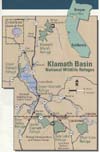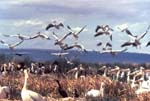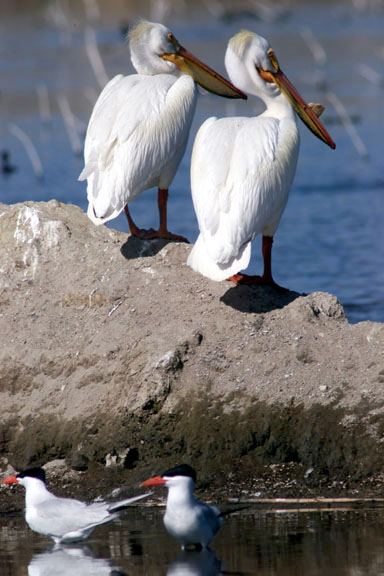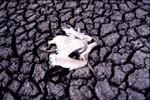|

Click to Expand Map |
|
The National Wildlife Refuges in the
Upper Klamath Basin are some of the most important in the country for migrating
waterfowl.
|
|

The Klamath wildlife refuges are also
the home of the largest population of American bald eagles still remaining in
the lower 48 states. |
|

Even though greatly diminished from its
original extent, the Klamath National Wildlife Refuges are still the home to
many species, including a large colony of pelicans, a species now slowly
recovering from near extinction (click to expand).

Abundant wildlife and a wide diversity of species
distinguishes the wildlife refuges when they are given the water they need.
Unfortunately this is increasingly rare as they lose more water in competition
with federally subsidized irrigation in the Klamath Irrigation
Project. |
|
|
|
|
|
|
HOME
| TAKE ACTION | MEDIA | FACTS |
RESOURCES |
|
| THE KLAMATH NATIONAL WILDLIFE
REFUGES |
|
|
|
In addition to the massive federal Klamath
Irrigation Project, the Upper Klamath Basin is the home to some of the oldest
and most important national wildlife refuges in the U.S. These refuges are used
by almost 90% of all migrating western North American waterfowl using the
Pacific Flyway, are the home to the largest population of bald eagles still
existing in the U.S. outside of Alaska, and are the overwintering and breeding
grounds for other bird species in great abundance. Most of these birds are
supposed to be federally protected under the Migratory Bird Treaty Act and by
international migratory bird protection treaty agreements with Canada and
Mexico.
Yet this tremendous public resource is
continually threatened by overallocation of scarce Upper Basin water to
commerical agriculture. Nearly every year, major portions of these national
wildlife refuges are deliberately dewatered by the U.S. Bureau of Reclamation
(BOR) to feed the irrigation demands of its overblown federal water project. In
2003, for instance, the volume of water that BOR is going to allow to flow to
the refuges is the lowest in at least 41 years.
The BOR also allows commercial row-crop farming
on 23,000 acres of wildlife refuge lands, complete with the use of pesticides
and other agricultural chemicals known to kill both birds and fish.
The BOR also holds the water flowing into the
refuges hostage, by insisting that the refuges get only irrigation return flows
(which are often highly polluted), even though the agency could chose to
provide cleaner water to the refuges directly at any time by opening just two
floodgates.
Figure 1: Nesting Pelicans in Clear Lake National
Wildlife Refuge need protected wetlands islands to protect their chicks.

Figure 2: Pelican nesting areas at Clear Lake
National Wildlife Refuge are frequently dewatered by Klamath Project irrigation
diversions, exposing nestlings to predators and destroying habitat (click to
expand).
 Figure 3: This is your Tule Lake National Wildlife Refuge in most years. The
water has gone instead to nearby commerical farms, some of them actually on the
national wildlife refuge itself. In most years now, the wildlife refuges are
seriously dewatered and millions of birds perish (click to expand).
Figure 3: This is your Tule Lake National Wildlife Refuge in most years. The
water has gone instead to nearby commerical farms, some of them actually on the
national wildlife refuge itself. In most years now, the wildlife refuges are
seriously dewatered and millions of birds perish (click to expand).
 Figure 4: Your Upper
Klamath National Wildlife Refuge, looking north. Klamath Project irrigators
received full water deliveries in 2002, but all of Upper Klamath National
Wildlife Refuge was once again left high and dry for the onset of fall
waterfowl migration (click to expand). Figure 4: Your Upper
Klamath National Wildlife Refuge, looking north. Klamath Project irrigators
received full water deliveries in 2002, but all of Upper Klamath National
Wildlife Refuge was once again left high and dry for the onset of fall
waterfowl migration (click to expand).
For more background information
see the Feb/March 2003 National Wildlife magazine article:
Troubled
Waters: Diking, Damming, Pollution and Competing Uses Threaten the 'Lifeblood'
of the National Wildlife Refuge System
The Klamath Basin Coalition
PO Box
1375
Eugene, OR 97440
Ph (541)689-2000
Email:
klamathcoalition@aol.com
|
|
|
|
|
|
|
|
|
|
|
|